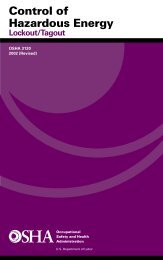Toxic Chemical Release Inventory Reporting Forms and Instructions
Toxic Chemical Release Inventory Reporting Forms and Instructions
Toxic Chemical Release Inventory Reporting Forms and Instructions
You also want an ePaper? Increase the reach of your titles
YUMPU automatically turns print PDFs into web optimized ePapers that Google loves.
Facility Eligibility Determination for Submitting an EPCRA Section 313 Report<br />
Otherwise Use: The term “otherwise use” means any use of<br />
an EPCRA section 313 chemical, including an EPCRA<br />
section 313 chemical contained in a mixture or other trade<br />
name product or waste, that is not covered by the terms<br />
“manufacture” or “process.” Otherwise use of an EPCRA<br />
section 313 chemical does not include disposal, stabilization<br />
(without subsequent distribution in commerce), or treatment<br />
for destruction unless:<br />
(1) The EPCRA section 313 chemical that was disposed,<br />
stabilized, or treated for destruction was received from offsite<br />
for the purposes of further waste management;<br />
or<br />
(2) The EPCRA section 313 chemical that was disposed,<br />
stabilized, or treated for destruction was manufactured as a<br />
result of waste management activities on materials received<br />
from off-site for the purposes of waste management<br />
activities. Relabeling or redistributing of the EPCRA section<br />
313 chemical where no repackaging of the EPCRA section<br />
313 chemical occurs does not constitute an otherwise use or<br />
processing of the EPCRA section 313 chemical.” (See 62 FR<br />
23846 <strong>and</strong> Part II, Section 3.3 of these instructions for<br />
further clarification).<br />
Example 3: Typical Otherwise Use Activities<br />
‘ When your facility cleans equipment with toluene, you are otherwise using toluene. Your facility also separates two<br />
components of a mixture by dissolving one component in toluene, <strong>and</strong> subsequently recovers the toluene from the<br />
process for reuse or disposal. Your facility otherwise uses toluene.<br />
‘ A covered facility receives a waste containing 12,000 pounds of <strong>Chemical</strong> A, a non-PBT EPCRA section 313<br />
chemical, from off-site. The facility treats the waste, destroying <strong>Chemical</strong> A <strong>and</strong> in the treatment process manufactures<br />
10,500 pounds of <strong>Chemical</strong> B, another non-PBT EPCRA section 313 chemical. <strong>Chemical</strong> B is disposed on-site. Since<br />
the waste containing <strong>Chemical</strong> A was received from off-site for the purpose of waste management, the amount of<br />
<strong>Chemical</strong> A must be included in the otherwise use threshold determination for <strong>Chemical</strong> A. The otherwise use threshold<br />
for a non-PBT chemical is 10,000 pounds <strong>and</strong> since the amount of <strong>Chemical</strong> A exceeds this threshold, all releases <strong>and</strong><br />
other waste management activities for <strong>Chemical</strong> A must be reported. <strong>Chemical</strong> B was manufactured in the treatment<br />
of a waste received from off-site. The facility disposed of <strong>Chemical</strong> B on-site. Since <strong>Chemical</strong> B was generated from<br />
waste received from off-site for treatment for destruction, disposal, or stabilization, the disposal of <strong>Chemical</strong> B is<br />
considered to be an otherwise use. Thus, the amount of <strong>Chemical</strong> B must be considered in the otherwise use threshold<br />
determination. Thus, the reporting threshold for <strong>Chemical</strong> B has also been exceeded <strong>and</strong> all releases <strong>and</strong> other waste<br />
management activities for <strong>Chemical</strong> B must be reported.<br />
B.3.b. Persistent Bioaccumulative<br />
<strong>Toxic</strong> (PBT) <strong>Chemical</strong>s <strong>and</strong><br />
<strong>Chemical</strong> Categories Overview<br />
On October 29, 1999 EPA published a final rule (64 FR<br />
58666) adding certain chemicals <strong>and</strong> chemical categories to<br />
the EPCRA section 313 list of toxic chemicals <strong>and</strong> lowering<br />
the reporting threshold for persistent bioaccumulative toxic<br />
(PBT) chemicals. In addition, on January 17, 2001 EPA<br />
published a final rule (66 FR 4500) that classified lead <strong>and</strong><br />
lead compounds as PBT chemicals <strong>and</strong> lowered their<br />
reporting thresholds. The lower reporting thresholds for lead<br />
applies to all lead except when lead is contained in a stainless<br />
steal, brass or bronze alloy.<br />
Dioxin <strong>and</strong> dioxin-like compounds, lead compounds,<br />
mercury compounds <strong>and</strong> polycyclic aromatic compounds<br />
(PACs) are the four PBT chemical categories with lower<br />
reporting thresholds. The 17 members of the dioxin <strong>and</strong><br />
dioxin-like compounds category <strong>and</strong> the 21 members of the<br />
PACs category are listed in Table IIc of these instructions.<br />
The dioxin <strong>and</strong> dioxin-like compounds category has the<br />
qualifier, “Manufacturing; <strong>and</strong> the processing or otherwise<br />
use of dioxin <strong>and</strong> dioxin-like compounds if the dioxin <strong>and</strong><br />
dioxin-like compounds are present as contaminants in a<br />
chemical <strong>and</strong> if they were created during the manufacturing<br />
of that chemical.”<br />
EPA has added six individual chemicals to the EPCRA<br />
section 313 list of toxic chemicals that also had their<br />
thresholds lowered: benzo(g,h,i)perylene, benzo(j,k)fluorene<br />
(fluoranthene), 3-methylcholanthrene, octachlorostyrene,<br />
pentachlorobenzene, <strong>and</strong> tetrabromobisphenol A (TBBPA).<br />
Benzo(j,k)fluorene <strong>and</strong> 3-methylcholanthrene were added as<br />
members of the polycyclic aromatic compounds (PACs)<br />
chemical category.<br />
14 <strong>Toxic</strong>s <strong>Release</strong> <strong>Inventory</strong> <strong>Reporting</strong> <strong>Forms</strong> <strong>and</strong> <strong>Instructions</strong>
















